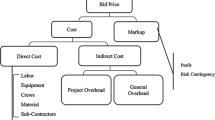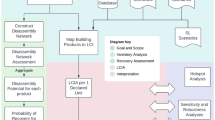Abstract
The construction industry has significant effects on global warming, and efforts are being made continuously to reduce environmental load. However, it is difficult to assess the environmental load at the planning phase of Social Overhead Capital (SOC) because it is impossible to obtain the necessary information for calculating the amount of resources used. In this study, a forecast model based on Case-based Reasoning (CBR) was developed and its reliability was evaluated. The purpose of this model is to estimate environmental load accurately and rapidly through Life Cycle Assessment (LCA) by using only 11 types of information for deduction during the planning phase for the road earthwork section of the SOC. The value of environmental load estimated by the asdeveloped model showed an average error of 19.21%. The reliability is approximately 18%P higher than that of the value estimated based on the basic unit (/m, /m2) that can be used at the planning phase. Thus, the capability to perform environmental load assessment through LCA with better reliability even with information that can be used at the planning phase of road facilities through the as-developed CBR-based environmental load estimation model is demonstrated.
Similar content being viewed by others
Change history
10 May 2017
This erratum is published to notice a spelling error in keywords.
References
Cass, D. and Mukherjee, A. (2011). “Calculation of greenhouse gas emission for highway construction operations using a hybrid life cycle assessment approach: A case study for pavement operations.” Journal of Construction Engineering and Management, ASCE, Vol. 137, No. 11, pp. 1015–1025, DOI: 10.1061/(ASCE)CO.1943-78862.0000349.
Chowdhury, R., Apul, D., and Fry, T. (2010). “A life cycle based environmental impacts assessment of construction materials used in road construction.” Resources conservation recycling, Elsevier Science B.V. Amsterdam, Vol. 54, No. 4, pp. 250–255, DOI: 10.1016/j.resconrec.2009.08.007.
Dogan, S., Arditi, D., and Gunaydin, H. (2006). “Determining attribute weights in a CBR model for early cost prediction of structural systems.” Journal of Construction Engineering and Management, ASCE, Vol. 132, No. 10, pp. 1092–1098, DOI: 10.1061/(ASCE) 0733-9364(2006)132..
Ecoinvent (2010). Ecoinvent data v2.2., released on April 14, 2010.
KAIA (Korea Agency for Infrastructure Technology Advancement) (2011). A study on approximate cost estimating model in national highway and river project, Korean Ministry of Land, Transport and Maritime Affairs, Seoul (in Korean).
Kim, J. H. (2013). A revision method considering qualitative variables in a CBR based cost prediction model, Dissertation, University of Seoul (in Korean).
Kim, K. H., Kim, S. Y., and Kang, K. I. (2004). “Comparing accuracy of prediction cost estimation using case based reasoning and neural networks.”, Journal of the Architectural Institute of Korea, AIK, Vol. 20, No. 5, pp. 93–102 (in Korean).
Kim, Y. S. (2010). MRA Revision model based on CBR for cost prediction in early phase. Dissertation, University of Seoul (in Korean).
Korean Ministry of Land, Transport and Maritime Affairs (2008). The Design Guide of National Highway (in Korean).
Kwak, S. N. (2007). Cost prediction model of planning and design phase using available information, Dissertation, Yonsei University (in Korean).
Kwon, S. H. (2008). Development of assessment model for environmental economics of construction projects, Dissertation, Chung-ang University (in Korean).
Lee, K. H. and Lee, K. H. (1996). “The estimation of amount of energy consumption and CO2 emission in construction activities.” Journal of the Architectural Institute of Korea, AIK, Vol. 12, No. 7, pp. 197–204 (in Korean).
Liu, C., Ahn, C., An, X., and Lee, S. (2013). “Life-cycle assessment of concrete dam construction: comparison of environmental impact of rock-filled and conventional concrete.” Journal of Construction Engineering and Management, ASCE, Vol. 139, No. 12, A4013009-1-11, DOI: 10.1061/(ASCE)CO.1943-7862.0000752.
Lowe, D. J., Emsley, M. W., and Harding, A. (2006). “Predicting construction cost using multiple regression techniques.” Journal of Construction Engineering and Management, ASCE, Vol. 7, No. 750, pp. 750–758, DOI: 10.1061/(ASCE)0733-9364(2006)132.
Moon, J., Ju, K., Seo, M., and Kang, L. (2014). “Evaluation of environmental stress for highway construction project by life cycle assessment method.” Journal of Construction Engineering and Management, KICEM, Vol. 15, No. 6, pp. 83–91 (in Korean).
Parrish, K. and Chester, M. (2014). “Life-cycle assessment for construction of sustainable infrastructure.” Practice Periodical on Structural Design and Construction, ASCE, Vol. 19, No. 1, pp. 19:89–94, DOI: 10.1061/(ASCE)SC.1943-5576.0000187.
Riesbeck, K. C. and Schank, C. R. (1989). Inside Case-based Reasoning, L. Erlbaum Associates Inc., New Jersey.
Treloar, G., Love, P., and Crawford, R. (2004). “Hybrid life-cycle inventory for road construction and use.” Journal of Construction Engineering and Management, ASCE, Vol. 1, No. 43, pp. 43–49, DOI: 10.1061/(ASCE)0733-9364(2004)130.
Trost, S. and Oberlender, G. (2003). “Prediction accuracy of early cost estimates using factor analysis and multivariate regression.” Journal of Construction Engineering and Management, ASCE, Vol. 2, No. 198, pp.198–204, DOI: 10.1061/(ASCE)0733-9364(2003)129.
Watson, I. (1997). Applying Cased Based Reasoning–Techniques for Enterprise System, Morgan Kaufmann Publisher Inc., California.
Wilmot, C. and Mei, B. (2005). “Neural network modeling of highway construction costs.” Journal of Construction Engineering and Management, ASCE, Vol. 7, No. 765, pp. 767–771, DOI: 10.1061/(ASCE)0733-9364(2005)131.
Yau, N. J. and Yang, J. B. (1998). “Case-based reasoning in construction management.” Journal of Computer-Aided Civil and Infrastructure Engineering, Blackwell Publishers, Vol. 13, No. 2, pp. 143–150, DOI: 10.1111/0885-9507.00094.
Yue, H., Roger, B., and Oliver, H. (2008). “Development of a life cycle assessment tool for construction and maintenance of asphalt pavements.” Journal of Cleaner Production, Elsevier Science B.V. Amsterdam, Vol. 17, No. 2, pp. 283–296, DOI: 10.1016/j.jclepro. 2008.06.005.
Author information
Authors and Affiliations
Corresponding author
Rights and permissions
About this article
Cite this article
Park, JY., Lee, DE. & Kim, BS. Development of environmental load-estimating model for road planning phase: Focus on road earthwork. KSCE J Civ Eng 22, 459–466 (2018). https://doi.org/10.1007/s12205-017-0029-8
Received:
Accepted:
Published:
Issue Date:
DOI: https://doi.org/10.1007/s12205-017-0029-8




